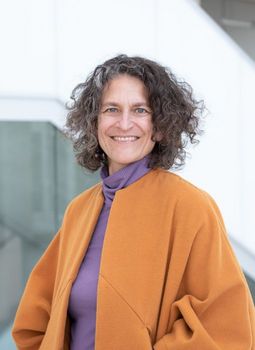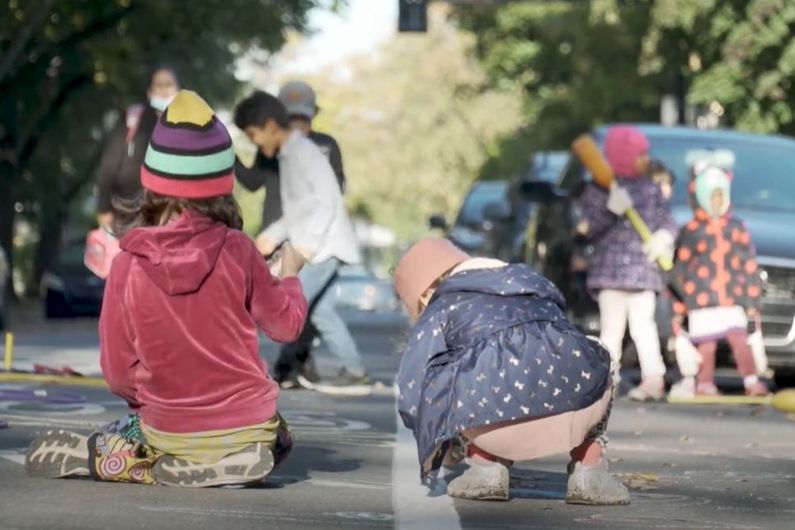
Katherine Frohlich
Credit: Amélie Philibert, Université de Montréal
It's 3:15 on a Friday afternoon at École Saint-Benoît, a primary school in the north end borough of Ahuntsic, and 'Big Ben' bell signals that school's out for the weekend. Waves of kids burst out into the courtyard behind the school, then come around to the street in front.
Usually there'd be some cars idling outside the building: parents coming to take their child home, swooping in after a fleet of yellow mini-buses picks up those among the school's autistic students who need a ride.
But today, the street belongs to the children who remain behind, over 300 of them.
Running, shouting, playing on the asphalt, they're the beneficiaries of a Université de Montréal research project - soon to be expanded to two other Montreal elementary schools - to make school streets car-free, at least for part of the day.
In French, the concept is called Rues écoles, and it's designed to address concerns over safety, traffic problems and kids not getting enough physical activity, something that worsened during the many months stuck at home during the COVID-19 pandemic.
Car-free school streets have been tried in other Canadian cities: Victoria, Vancouver, Winnipeg, Toronto and Markham. In Montreal, for two years now, École Saint-Benoît has been the concept's proving ground.
Co-funded by the Canadian Institutes of Health Research, the Mitacs 'Accelerate' program and the City of Montreal, the pilot project in Ahuntsic is co-led by UdeM public-health expert Katherine Frohlich and the Montreal not-for-profit organization Centre d'écologie urbaine.
They're calling it 'Levelling the Playing Fields' - in French, Changer les règles du jeu.
"It wasn't simple to set up, but the results are clear to see," said Frohlich, a professor at UdeM's École de santé publique (ESPUM).
"It seems that all it takes is the temporary closing of a street to permit hundreds of kids to go out and play - and that means that they're happier and healthier and full of joy," Frohlich said during a late April visit to Saint-Benoît to see the plan in action.
Nancy Gagnon couldn't agree more. On this sunny Friday afternoon, she came on foot to pick up her 9-year-old daughter, Emma, and to mingle with the other local parents on Mont-Cassin Avenue, in front of the school.
"We moved into this neighbourhood when Emma was in the middle of Grade 3, and having this chance to play in the street after school really helped her integrate and get to know a lot of the other kids," Gagnon said.
"In the schoolyard, the kids are separated by age group, but here in the street, they mix more," she said. Added Emma: "I've made new friends. They're not the same ones from my class and being outside means you get fresh air."
Like every Friday afternoon after school, volunteers in orange safety vests today have blocked off the street at both ends, letting cars in or out only if it's a resident coming or going home. When that happens, the volunteers walk alongside, a buffer between car and kids.
On the street, some of the children have set up nets to play ball hockey. Some kick a soccer ball around. Others skip rope, play tag, gather in groups and chatter about what happened in school today or what they'll be doing over the weekend.
"Of course, in winter, when it's cold, we get a lot fewer kids out here," said Denis Boivin, the school's principal. "But now that the warmer weather is here, many are even calling home at the end of the day to ask if they can stay after school. It's great."
After an hour, when it's time to go, most of the kids leave on foot, or on their bike, or on their scooter. Many make their way home unaccompanied by a parent; before the program was put in place two years ago, only one in three did so.
Ten per cent fewer arrive by car in the morning now, too. There's less traffic on the street, fewer drivers doing U-turns in front of the school, and not as much worry over safety in the minds of parents, said Boivin.
"Thanks to the research that went into this at Université de Montréal, we have numbers to prove that the program works, and that's made it easier to explain to parents, to residents, to city officials. It's not just us saying it's a good thing; that's what the data show."
In 2025, the project will tried out at Guillaume-Couture and Saint-Clément primary schools in Hochelaga-Maisonneuve, three days a week. Why not four, or five? Because it's hard to find and retain volunteers, said Manuel Moreau, one of five helping out at École Saint-Benoît today.
"Often it's parents and even grandparents who pitch in, but they disappear when the child leaves and goes off to high school," he explained. "Mobilizing people to help out is always a challenge."
So is coordinating things at the local government level. École Saint-Benoît is in Ahuntsic city councillor Nathalie Goulet's district, and she had to work with the police, the city transit authority, and many others to make the Rues écoles project a reality.
"It's rare that we see projects as multi-partnered as this one - and it's an exceptional one," she said at the late April event. "There's the borough, and the school, and the community, all coming together for the benefit of the children."
After all, Goulet said, "kids are citizens, too, and they should feel at home in their city."
In North America, where the car is still king, it can take some convincing for parents to give up driving their kids to and from school even for just one day a week. Perhaps it's time to design cities so that some schools aren't directly accessible by car, some experts believe.
"That's an acceptable idea in Europe," said Julie Karmann, an ESPUM doctoral student in landscape design from Metz, France, who came to observe the after-school activities at Saint-Benoît today.
"Where I'm from, many schools are fronted by a parvis, a pedestrian forecourt where parents can gather to drop off or pick up their child on foot. These areas may not be specifically dedicated to play, but that's often how the children use them."
Simply put, removing cars from in front of schools - even if only for a couple of hours in a day - "is another way of sharing public space," said Véronique Fournier, who heads the Centre d'écologie urbaine.
The Saint-Benoît project is "an inspiring example - and it's beginning to have a snowball effect in other parts of Quebec."
Watch the video
To see what the 'Levelling the Playing Fields' project looks like, check out the short video produced by the Centre d'écologie urbaine.







